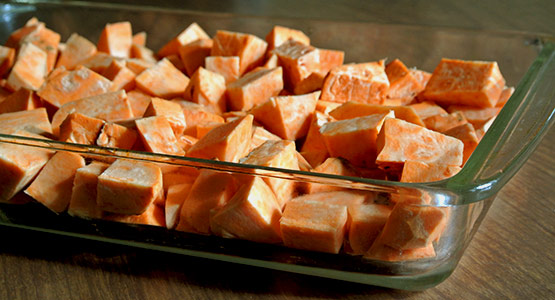The old adage “Let food be your medicine” is certainly foundational to Ayurveda. The science has an expansive view of nutrition. It understands how individual foods, combinations of foods and preparation methods can all impact your wellbeing.
As we move from winter to spring, the moist and dense energy of Kapha heightens. We see it in colds, allergies and our own sluggishness. To bring alignment, think in opposite terms. It is time to integrate more food and lifestyle decisions that bring lightness, movement and warmth. In Ayurveda, your cooking preparation method is one way to shift the biological energies. Roasting is ideal for keeping Kapha energy in check.
Roasting is a dry heat preparation method. It comes from the tradition of roasting over an open fire. The focus is on caramelizing and browning the food’s exterior, while keeping a tender, moist interior. All you need is a large and shallow roasting pan, a bit of oil and you are good to go!
Here are some things to consider when roasting vegetables:
Go Seasonal, Local and Organic
Select vegetables that are in season and 100% organic—ideally from your local farmer’s market. Conventionally farmed veggies are exposed to and absorb shocking amounts of toxins and pesticides. Plus, they are often sprayed or coated with chemicals to inhibit sprouting. Firm vegetables, such as root vegetables, work best for roasting.
All oils have different smoke points. A smoke point is the temperature at which an oil’s properties start to change. When oils reach or exceed their smoke point, they begin to become toxic, or unsuitable for consumption.
Stick with Lower Temperature Ranges
Roasting temperature recommendations range from 250° F to 450° F. The case for a high heat is that it will give your veggies a nice char. Ayurveda, of course, would counsel that a lower cooking temperature is healthier. This might extend cook time and diminish the rustic coating a bit, but it’s worth it for your wellbeing!
Choose Oil Wisely
Roasting requires coating your vegetables in oil. Contrary to popular belief, olive oil is not suitable for roasting. It has a very low smoke point. Sesame oil, almond oil, avocado oil or melted ghee (clarified butter) are all good oils to use if you are following Ayurvedic guidelines.
Instructions for Roasting:
Tips on how to roast can vary significantly. Below is a general “how to” explanation:
In Ayurveda, it is generally advised to eat your vegetables without peeling them. Skins are full of nutrition. They provide added roughage. And, if you buy 100% organic food, you don’t need to worry about unwanted chemicals.
- Start the roasting process by preheating your oven (and shallow roasting pan) to the desired temperature.
- Once washed, peel (only if necessary) and cut your vegetables into uniform pieces. For small bits, think 1” squares. Uniformity is important because it enables the vegetables to cook evenly.
- Pour your chosen oil over the chopped veggies. Thoroughly stir the mixture to make sure the vegetables are all lightly coated. Depending on vegetable quantity, you will use between 1 to 3 tablespoons. In Ayurveda, the closer it is to spring, the less oil you want to put on your root veggies. (This is also the case if you have a Kapha imbalance.) During springtime, we naturally become more lubricated, so a dryer preparation is recommended.
- Remove the pre-heated pan from the oven and thinly coat it with oil (about 1-2 tablespoons).
- Sprinkle the mixture with appropriate seasonings (salt, pepper, etc.) and spread in a single layer across your pre-heated roasting pan. It is best to space out your veggies. This enables their moisture to evaporate. Do not cover.
- Place the pan back into the oven and cook until desired tenderness (typically 25 to 45 minutes), tossing the vegetables at least once during the process. A general recommendation is to toss them at 20 minutes and then again every 10 minutes after that. Vegetables are generally cooked when you can put a knife through them with no resistance.
- Remove the veggies from the oven and serve. Or, sprinkle them with appropriate seasonings and/or liquid for coating (see below).
- Savor the flavorful goodness that comes out during the roasting process. Yum!
Extra Flavors:
Roasting intensifies the flavors of your vegetables and heightens their sugar content. If your vegetables do not seem delicious enough solo, try adding some simple spices or a liquid to take them over the edge. Remember to add your flavoring(s) as soon as the roasted vegetables leave the oven.
- Maple syrup: We are talking about the real stuff, of course. No high fructose corn syrup here! Add a tablespoon or two to the roasted vegetables to lightly coat them. (This takes brussel sprouts to a new place. Friends and family will be begging for your recipe!)
- Chopped nuts: Finely chop some nuts (walnuts, pecans or even cashews) and sprinkle over your veggies. They add flavor and texture, especially to potatoes.
- Shaved coconut: Sprinkle your sweet potatoes with a light layer of finely shaved coconut. It will make for a doubly sweet treat.
- Vinegar: Beets go well with vinegar. Try tossing your roasted beets with vinegar and an additional splash of oil.
- Rosemary: Some will say that everything tastes better with rosemary on top. Finely chop a few teaspoons of fresh rosemary and add it to your favorite root vegetable medley.
- Roasted spices: There are a million and one exciting combinations of roasted spices. Take whole spices and lightly roast them over low heat. When their aroma intensifies, remove from heat and allow them to cool. Once cooled, grind them and sprinkle atop your hot roasted veggies. Cumin, fennel, cinnamon, black pepper and saffron are just a few of your options.
Roasting is an easy way to add more vegetables to your diet. Simply chop, coat and place them in the oven. Done!


